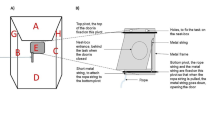Abstract
Detour behaviour is the ability of an animal to reach a goal stimulus by moving round any interposed obstacle. It has been widely studied and has been proposed as a test of insight learning in several species of mammals, but few data are available in birds. A comparative study in three species of birds, belonging to different eco-ethological niches, allows a better understanding of the cognitive mechanism of such detour behaviour. Young quails (Coturnix sp.), herring gulls (Larus cachinnans) and canaries (Serinus canaria), 1 month old, 10–25 days old and 4–6 months old, respectively, were tested in a detour situation requiring them to abandon a clear view of a biologically interesting object (their own reflection in a mirror) in order to approach that object. Birds were placed in a closed corridor, at one end of which was a barrier through which the object was visible. Four different types of barrier were used: vertical bar, horizontal bar, grid and transparent. Two symmetrical apertures placed midline in the corridor allowed the birds to adopt routes passing around the barrier. After entering the apertures, birds could turn either right or left to re-establish social contact with the object in the absence of any local sensory cues emanating from it. Quails appeared able to solve the task, though their performance depended on the type of barrier used, which appeared to modulate their relative interest in approaching the object or in exploring the surroundings. Young herring gulls also showed excellent abilities to locate spatially the out-of-view object, except when the transparent barrier was used. Canaries, on the other hand, appeared completely unable to solve the detour task, whatever barrier was in use. It is suggested that these species differences can be accounted for in terms of adaptation to a terrestrial or aerial environment.






Similar content being viewed by others
References
Bitterman ME (1960) Toward a comparative psychology of learning. Am Psychol 15:704–712
Chapuis N (1987) Detour and shortcut abilities in several species of mammals. In: Ellen P, Thinus-Blanc C (eds) Cognitive processes and spatial orientation in animal and man. Nijhoff, Dordrecht, pp 97–106
Etienne AS (1973) Searching behaviour towards a disappearing prey in the domestic chick as affected by preliminary experience. Anim Behav 21:749–761
Etienne AS (1974) Age variability shown by domestic chicks in selected spatial tasks. Behaviour 50:52–76
Freire R, Nicol CJ (1999) Effect of experience of occlusion events on the domestic chick’s strategy for locating a concealed imprinting object. Anim Behav 58:593–599
Köhler W (1925) The mentality of apes. Harcourt Brace, New York
Krushinskii LV (1970) Objective study of elementary reasoning in animals. Scientia 64:470–482
Miglino O, Denaro D, Tascini S, Parisi D (1998) Detour behaviour in evolving neural networks. Proceedings of the first European workshop on evolutionary robotics, Paris, pp 112–125
Miller DB (1974) A comparative analysis of detour behaviour in ring doves (Streptopelia risoria) and rock doves (Columba livia) as a function of barrier mesh density. Dissertation Abstracts International, vol XXXIV, N.7
Miller DB, Tallarico RB (1974) On the correlation of brain size and problem-solving behaviour of ring doves and pigeons. Brain Behav Evol 10:265–273
Pastore N (1954a) Spatial learning in the canary. J Comp Physiol Psychol 47:288–289
Pastore N (1954b) Discrimination learning in the canary. J Comp Physiol Psychol 47:389–390
Pastore N (1955a) Discrimination and delayed response learning in the canary. Psychol Rep 1:307–315
Pastore N (1955b) Learning in the canary. Sci Am 5:72–79
Piaget J (1954) The child’s construction of reality (M. Cook, trans.). Basic Books, New York (original work published 1937)
Regolin L, Vallortigara G, Zanforlin M (1994) Perceptual and motivational aspects of detour behaviour in young chicks. Anim Behav 47:123–131
Regolin L, Vallortigara G, Zanforlin M (1995a) Object and spatial representations in detour problems by chicks. Anim Behav 49:195–199
Regolin L, Vallortigara G, Zanforlin M (1995b) Detour behaviour in the domestic chick: searching for a disappearing prey or a disappearing social partner. Anim Behav 50:203–211
Rogers JL (1997) Minds of their own. Allen and Unwin, Australia
Scholes NW (1965) Detour learning and development in the domestic chick. J Comp Physiol Psychol 60:114–116
Scholes NW, Wheaton LG (1966) Critical period for detour learning in developing chicks. Life Sci 5:1859–1865
Tinbergen N (1976) The herring gull’s world. Collins, London, pp 176–181
Vallortigara G (2004) Visual cognition and representation in birds and primates. In: Rogers LJ, Kaplan G (eds) Vertebrate comparative cognition: are primates special? Kluwer/Plenum, London, pp 57–94
Vallortigara G, Regolin L (2002) Facing an obstacle: lateralization of object and spatial cognition. In: Andrew RJ, Rogers LJ (eds) Comparative vertebrate lateralization. Cambridge University Press, Cambridge, pp 383–444
Vallortigara G, Regolin L, Rigoni M, Zanforlin M (1998) Delayed search for a concealed imprinted object in the domestic chick. Anim Cogn 1:17–24
Vallortigara G, Regolin L, Pagni P (1999) Detour behaviour, imprinting, and visual lateralization in the domestic chick. Cogn Brain Res 7:307–320
Acknowledgements
We would like to thank Dr Marco Stebel, General Manager of the C.S.P.A.-Animal House of Trieste University, for assistance during the experimental work and Dr Tatiana Czeschlik for comments that stimulated us to make many improvements to this paper. The experiments described here comply with the Italian laws about animal welfare and wildlife.
Author information
Authors and Affiliations
Corresponding author
Rights and permissions
About this article
Cite this article
Zucca, P., Antonelli, F. & Vallortigara, G. Detour behaviour in three species of birds: quails (Coturnix sp.), herring gulls (Larus cachinnans) and canaries (Serinus canaria). Anim Cogn 8, 122–128 (2005). https://doi.org/10.1007/s10071-004-0243-x
Received:
Revised:
Accepted:
Published:
Issue Date:
DOI: https://doi.org/10.1007/s10071-004-0243-x




